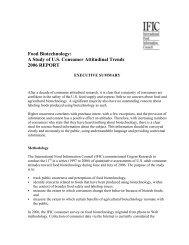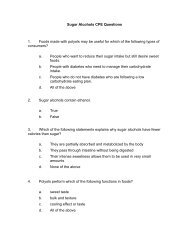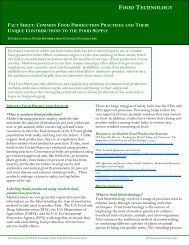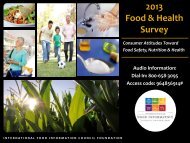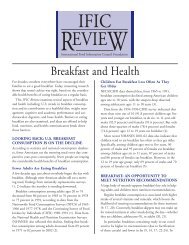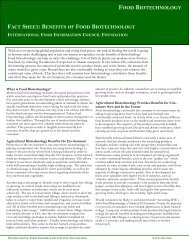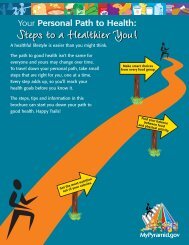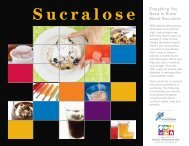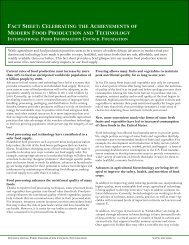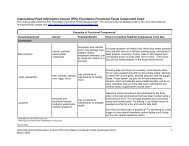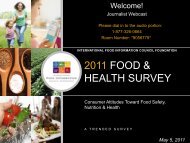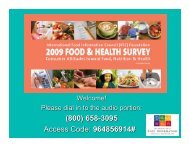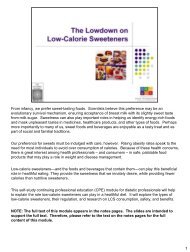from farm to fork: questions and answers about modern food
from farm to fork: questions and answers about modern food
from farm to fork: questions and answers about modern food
You also want an ePaper? Increase the reach of your titles
YUMPU automatically turns print PDFs into web optimized ePapers that Google loves.
FROM FARM TO FORK:<br />
QUESTIONS AND ANSWERS ABOUT MODERN FOOD PRODUCTION<br />
With an increasing focus on nutrition <strong>and</strong> health by American consumers has come greater<br />
curiosity <strong>about</strong> where our <strong>food</strong> comes <strong>from</strong> <strong>and</strong> how it is produced. Concerns voiced in the media<br />
center around the safety <strong>and</strong> health of the U.S. <strong>food</strong> supply, which <strong>food</strong> manufacturers<br />
increasingly utilize <strong>modern</strong> technologies <strong>to</strong> produce. The following Q&A provides a brief<br />
glimpse in<strong>to</strong> some of the most common <strong>questions</strong> <strong>about</strong> <strong>modern</strong> <strong>food</strong> technology <strong>and</strong> its impact<br />
on <strong>food</strong> safety, nutrition, health, <strong>and</strong> the environment.<br />
How has technology improved the way <strong>food</strong> is produced<br />
The use of technology in <strong>modern</strong> agriculture began with the replacement of the horse with<br />
<strong>modern</strong> trac<strong>to</strong>rs, combines, <strong>and</strong> cot<strong>to</strong>n pickers after the turn of the 20 th century. The next<br />
revolution in crop production began in the 1930s with “hybridization” of crops, or the breeding of<br />
select crops <strong>to</strong> produce desirable characteristics not typically found in the original crop. As a<br />
result, crop yields have increased <strong>from</strong> 25 bushels per acre in 1930 <strong>to</strong> more than 140 bushels<br />
<strong>to</strong>day. During the 1940s came increased availability of fertilizers <strong>to</strong> further increase crop yields,<br />
<strong>and</strong> in the 1950s we saw the introduction of herbicides, insecticides, <strong>and</strong> fungicides <strong>to</strong> help<br />
control weeds, insects <strong>and</strong> diseases that can reduce crop growth. In the mid 1990s, the<br />
introduction of <strong>food</strong> biotechnology helped <strong>to</strong> increase the quantity <strong>and</strong> quality of the <strong>food</strong>s we<br />
grow by making them <strong>to</strong>lerant of pesticides <strong>and</strong> preserving nutrients <strong>and</strong> other desirable traits. As<br />
with other industries, <strong>farm</strong>ers have had much <strong>to</strong> gain <strong>from</strong> the availability of computers, software,<br />
satellites, <strong>and</strong> the Internet. Such technologies enable <strong>farm</strong>ers <strong>to</strong> practice what is often referred <strong>to</strong><br />
as “precision agriculture,” which gives them the ability <strong>to</strong> more effectively use crop inputs such<br />
as fertilizers, pesticides, tilled or cultivated l<strong>and</strong>, <strong>and</strong> irrigation water. More effective use of these<br />
inputs means greater crop yield <strong>and</strong>/or quality, without polluting the environment. Additionally,<br />
since 1930, the time necessary <strong>to</strong> produce a bushel of corn has decreased <strong>from</strong> more than 30<br />
minutes <strong>to</strong> a fraction of a minute in 2002. Consumers are the major beneficiary of all of these<br />
developments. The Government Accounting Office (GAO) reported in June 2009 that household<br />
spending on <strong>food</strong> decreased <strong>from</strong> 13% of disposable income in 1982 <strong>to</strong> 10%, which is<br />
significantly less than the 25% of income Americans spent on <strong>food</strong> in the 1930s.<br />
How does the safety of <strong>to</strong>day’s U.S. <strong>food</strong> supply compare <strong>to</strong> 50 years ago<br />
The U.S. <strong>food</strong> supply is one of the safest in the world, <strong>and</strong> it is safer <strong>to</strong>day than it was 50 years<br />
ago. Food safety is the primary goal of all <strong>food</strong> <strong>and</strong> beverage producers. Detection of <strong>food</strong>borne<br />
pathogens was once limited <strong>to</strong> time-consuming labora<strong>to</strong>ry tests; however, <strong>to</strong>day many newer<br />
technologies, such as Hazard Analysis <strong>and</strong> Critical Control Points (HACCP), make detection<br />
easier than ever before. In addition, bacteria-removing procedures such as <strong>food</strong> irradiation, antimicrobial<br />
washes, <strong>and</strong> bacterial sprays, enable the rapid removal of potentially harmful<br />
substances <strong>from</strong> <strong>food</strong>s before they are shipped <strong>to</strong> the s<strong>to</strong>re. The U.S. Centers for Disease Control<br />
<strong>and</strong> Prevention (CDC), which is in charge of tracking <strong>food</strong>borne illness outbreaks, reported that<br />
the number of E coli O157:H7 cases declined by 40% between 2000 <strong>and</strong> 2007, <strong>and</strong> the incidence<br />
of listeriosis declined 10%. While the <strong>to</strong>tal number of Salmonella cases <strong>from</strong> all <strong>food</strong> sources<br />
increased between 2007 <strong>and</strong> 2008, the U.S Department of Agriculture (USDA) says it has seen a<br />
significant reduction in the presence of Salmonella in raw meat <strong>and</strong> poultry since the<br />
development of its Salmonella Initiative Program in 2006. In response <strong>to</strong> the increase in<br />
Salmonella cases, CDC says it plans <strong>to</strong> “increase the capacity of several health departments so<br />
that outbreaks can be better detected <strong>and</strong> investigated.” (CDC, April 9, 2009) While<br />
improvements can always be made, the U.S. <strong>food</strong> safety system is regarded globally as the gold<br />
st<strong>and</strong>ard for <strong>food</strong> safety.
Are processed/pre-packaged <strong>food</strong>s contributing <strong>to</strong> obesity, diabetes, <strong>and</strong><br />
cardiovascular disease in the U.S.<br />
The American Dietetic Association’s (ADA) position statement on the “Total Diet Approach <strong>to</strong><br />
Communicating Food <strong>and</strong> Nutrition Information” states that the <strong>to</strong>tal diet is the most important<br />
focus of a healthful eating style. This type of approach <strong>to</strong> eating, rather than focusing on specific<br />
nutrients or <strong>food</strong>s, can help reduce consumer confusion <strong>about</strong> <strong>food</strong> <strong>and</strong> health. All <strong>food</strong>s can fit<br />
in<strong>to</strong> a healthful diet if consumed in moderation <strong>and</strong> along with regular physical activity.<br />
Classifying certain <strong>food</strong>s or <strong>food</strong> categories as “good” or “bad” may foster unhealthy eating<br />
behaviors.<br />
Can organic <strong>farm</strong>ing alone feed the world’s growing population<br />
No. In a report by the Deutsche Bank Climate Change Advisors, produced in collaboration with<br />
The Nelson Institute's Center for Sustainability <strong>and</strong> the Global Environment at the University of<br />
Wisconsin, Madison (June 2009), organic <strong>farm</strong>ing was singled out as having the potential “<strong>to</strong><br />
contribute substantially <strong>to</strong> the global <strong>food</strong> supply while reducing environmental impacts.”<br />
However, it questioned whether the organic methods currently in use can be used on a large<br />
enough scale <strong>to</strong> feed the growing population. “The caloric needs of the planet will soar 50% by<br />
2050.” With the global population expected <strong>to</strong> reach nine billion by 2050, investment in both<br />
genetically engineered crops <strong>and</strong> organic <strong>farm</strong>ing could help <strong>to</strong> ensure a reliable <strong>food</strong> supply.<br />
Can I consume a nutritious diet on a limited budget<br />
Yes. The U.S. Department of Agriculture (USDA) offers a program called the Thrifty Food Plan<br />
(http://www.cnpp.usda.gov/USDAFoodPlansCos<strong>to</strong>fFood.htm), which serves as a national<br />
st<strong>and</strong>ard for consuming a nutritious diet at low cost. It provides cost-effective meal plan options<br />
that people of specific age <strong>and</strong> gender groups can consume at home <strong>to</strong> maintain a healthful diet<br />
that meets current dietary st<strong>and</strong>ards. The cost of the meal plans for each age/gender category is<br />
calculated based on average national <strong>food</strong> prices, adjusted for inflation. Based on 2009 data, a<br />
family of four earning less than $3,300 per month (or less than $40,000 per year) could purchase<br />
the necessary <strong>food</strong>s <strong>and</strong> ingredients <strong>to</strong> prepare <strong>and</strong> consume 21 nutritious home-cooked meals<br />
(that’s three meals per day) for just $117.50 per week.<br />
For more information on <strong>modern</strong> <strong>food</strong> production, visit the Agricultural Practices & Food<br />
Technologies page of the International Food Information Council Foundation Web site,<br />
www.<strong>food</strong>insight.org.<br />
International Food Information Council Foundation<br />
Oc<strong>to</strong>ber 2009<br />
www.<strong>food</strong>insight.org



